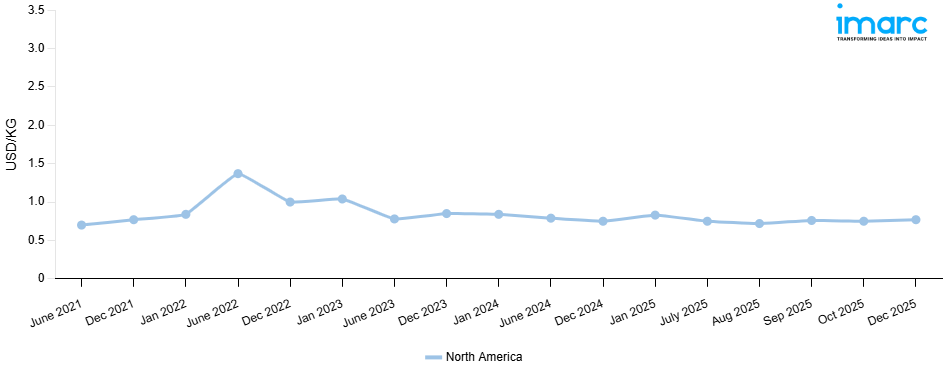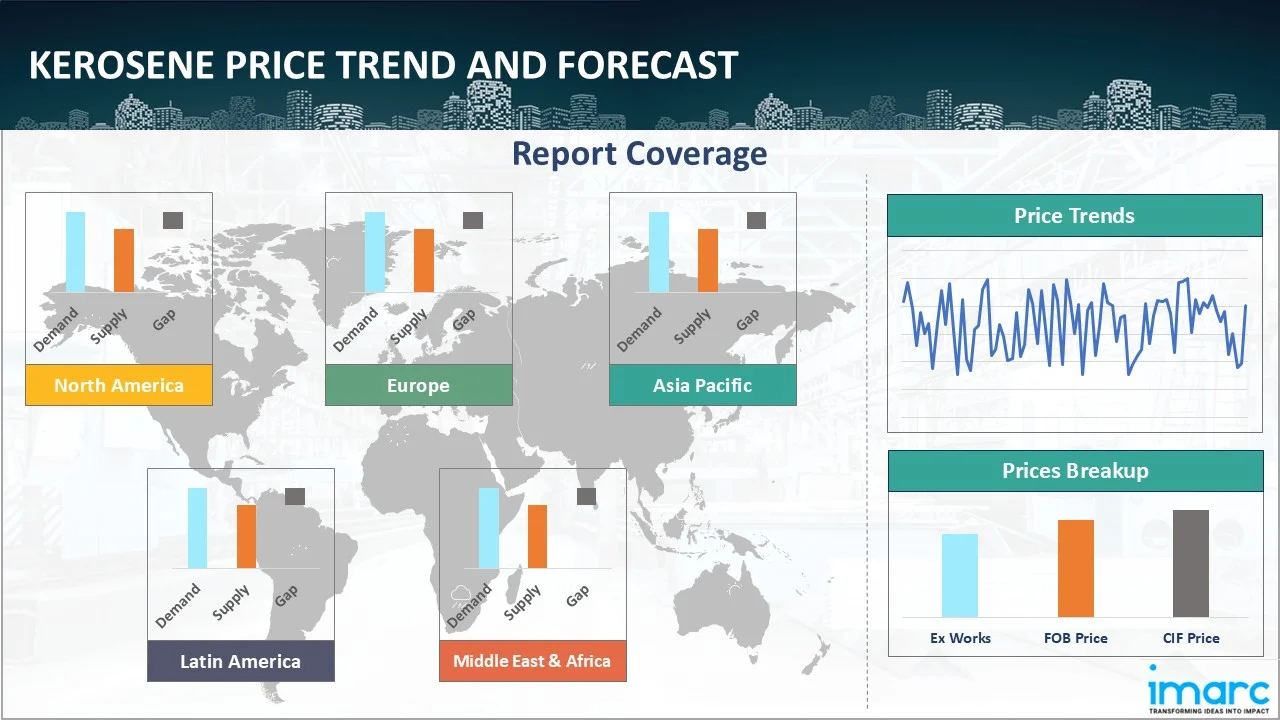
Kerosene Prices, Trend, Chart, Demand, Market Analysis, News, Historical and Forecast Data Report 2025 Edition
Kerosene Price Trend, Index and Forecast
Track real-time and historical kerosene prices across global regions. Updated monthly with market insights, drivers, and forecasts.
Kerosene Prices December 2025
| Region | Price (USD/Kg) |
|---|---|
| North America | 0.77 |
Kerosene Price Index (USD/KG):
The chart below highlights monthly kerosene prices across different regions.

Get Access to Monthly/Quarterly/Yearly Prices, Request Sample
Market Overview Q3 Ending September 2025
North America: Kerosene prices in North America increased this quarter, supported by stronger demand in the aviation and heating sectors. The kerosene price index reflected higher procurement activity as airlines and industrial users increased consumption. Seasonal factors also contributed to firmer demand, while moderate supply constraints arising from refinery turnarounds supported upward momentum. Rising crude oil values and higher logistics costs further reinforced the bullish trend. Overall, market sentiment remained firm, with buyers accepting higher prices due to steady downstream requirements.
Kerosene Price Trend, Market Analysis, and News
IMARC's latest publication, “Kerosene Prices, Trend, Chart, Demand, Market Analysis, News, Historical and Forecast Data Report 2025 Edition,” presents a detailed examination of the kerosene market, providing insights into both global and regional trends that are shaping prices. This report delves into the spot price of kerosene at major ports and analyzes the composition of prices, including FOB and CIF terms. It also presents detailed kerosene prices trend analysis by region, covering North America, Europe, Asia Pacific, Latin America, and Middle East and Africa. The factors affecting kerosene pricing, such as the dynamics of supply and demand, geopolitical influences, and sector-specific developments, are thoroughly explored. This comprehensive report helps stakeholders stay informed with the latest market news, regulatory updates, and technological progress, facilitating informed strategic decision-making and forecasting.

Kerosene Industry Analysis
The global kerosene industry size reached 8.85 Million BPD in 2025. By 2034, IMARC Group expects the market to reach 11.15 Million BPD, at a projected CAGR of 2.40% during 2026-2034. Growth is driven by increasing demand from aviation, industrial heating, and residential energy use, alongside rising consumption in emerging economies where kerosene continues to play a key role in energy supply.
Latest developments in the Kerosene Industry:
- March 2025: The Indian Space Research Organisation (ISRO) successfully conducted the first hot test of its 200-tonne thrust semi-cryogenic engine using a LOX-kerosene fuel combination at the ISRO Propulsion Complex, Mahendragiri. The semi-cryogenic engine, powered by a LOX-kerosene propellant combination, is being developed to boost the payload capacity of the LVM3 launch vehicle and strengthen its capability for upcoming space missions.
- January 2023: Bharat Petroleum Corporation Limited (BPCL) launched a new low-smoke Superior Kerosene Oil (SKO) for the Indian Army in Jammu, marking the first time an oil marketing company (OMC) had initiated the supply of LSLA-grade SKO. The cleaner-burning variant is designed to reduce smoke and odor, significantly improving living conditions for soldiers operating in high-altitude regions with low oxygen levels.
Product Description
Kerosene is a refined petroleum product derived from the distillation of crude oil, typically in the range of C9–C16 hydrocarbons. It is a clear, flammable liquid with moderate volatility and a relatively high flash point compared to gasoline. Kerosene is widely used as aviation turbine fuel (jet fuel), as a heating and lighting fuel in residential and industrial applications, and as a solvent in certain chemical processes. It offers efficient combustion, high energy density, and versatility across multiple applications. In developing regions, it remains a critical household fuel, while in industrialized economies, its primary use is in aviation and heating.
Report Coverage
| Key Attributes | Details |
|---|---|
| Product Name | Kerosene |
| Report Features | Exploration of Historical Trends and Market Outlook, Industry Demand, Industry Supply, Gap Analysis, Challenges, Ammonia Price Analysis, and Segment-Wise Assessment. |
| Currency/Units | US$ (Data can also be provided in local currency) or Metric Tons |
| Region/Countries Covered | The current coverage includes analysis at the global and regional levels only. Based on your requirements, we can also customize the report and provide specific information for the following countries: Asia Pacific: China, India, Indonesia, Pakistan, Bangladesh, Japan, Philippines, Vietnam, Thailand, South Korea, Malaysia, Nepal, Taiwan, Sri Lanka, Hongkong, Singapore, Australia, and New Zealand* Europe: Germany, France, United Kingdom, Italy, Spain, Russia, Turkey, Netherlands, Poland, Sweden, Belgium, Austria, Ireland, Switzerland, Norway, Denmark, Romania, Finland, Czech Republic, Portugal and Greece* North America: United States and Canada Middle East & Africa: Saudi Arabia, UAE, Israel, Iran, South Africa, Nigeria, Oman, Kuwait, Qatar, Iraq, Egypt, Algeria, and Morocco* Latin America: Brazil, Mexico, Argentina, Columbia, Chile, Ecuador, Peru* *The list of countries presented is not exhaustive. Information on additional countries can be provided if required by the client. |
| Information Covered for Key Suppliers |
|
| Customization Scope | The report can be customized as per the requirements of the customer |
| Report Price and Purchase Option |
Plan A: Monthly Updates - Annual Subscription
Plan B: Quarterly Updates - Annual Subscription
Plan C: Biannually Updates - Annual Subscription
|
| Post-Sale Analyst Support | 360-degree analyst support after report delivery |
| Delivery Format | PDF and Excel through email (We can also provide the editable version of the report in PPT/Word format on special request) |
Key Benefits for Stakeholders:
- IMARC’s report presents a detailed analysis of kerosene pricing, covering global and regional trends, spot prices at key ports, and a breakdown of FOB and CIF prices.
- The study examines factors affecting kerosene price trend, including input costs, supply-demand shifts, and geopolitical impacts, offering insights for informed decision-making.
- The competitive landscape review equips stakeholders with crucial insights into the latest market news, regulatory changes, and technological advancements, ensuring a well-rounded, strategic overview for forecasting and planning.
- IMARC offers various subscription options, including monthly, quarterly, and biannual updates, allowing clients to stay informed with the latest market trends, ongoing developments, and comprehensive market insights. The kerosene price charts ensure our clients remain at the forefront of the industry.
Key Questions Answered in This Report
The kerosene price in December 2025 was 0.77 USD/KG in North America.
The kerosene pricing data is updated on a monthly basis.
We provide the pricing data primarily in the form of an Excel sheet and a PDF.
Yes, our report includes a forecast for kerosene prices.
The regions covered include North America, Europe, Asia Pacific, Middle East, and Latin America. Countries can be customized based on the request (additional charges may be applicable).
Yes, we provide both FOB and CIF prices in our report.
Need more help?
- Speak to our experienced analysts for insights on the current market scenarios.
- Include additional segments and countries to customize the report as per your requirement.
- Gain an unparalleled competitive advantage in your domain by understanding how to utilize the report and positively impacting your operations and revenue.
- For further assistance, please connect with our analysts.
Why Choose Us
IMARC offers trustworthy, data-centric insights into commodity pricing and evolving market trends, enabling businesses to make well-informed decisions in areas such as procurement, strategic planning, and investments. With in-depth knowledge spanning more than 1000 commodities and a vast global presence in over 150 countries, we provide tailored, actionable intelligence designed to meet the specific needs of diverse industries and markets.
1000
+Commodities
150
+Countries Covered
3000
+Clients
20
+Industry
Robust Methodologies & Extensive Resources
IMARC delivers precise commodity pricing insights using proven methodologies and a wealth of data to support strategic decision-making.
Subscription-Based Databases
Our extensive databases provide detailed commodity pricing, import-export trade statistics, and shipment-level tracking for comprehensive market analysis.
Primary Research-Driven Insights
Through direct supplier surveys and expert interviews, we gather real-time market data to enhance pricing accuracy and trend forecasting.
Extensive Secondary Research
We analyze industry reports, trade publications, and market studies to offer tailored intelligence and actionable commodity market insights.
Trusted by 3000+ industry leaders worldwide to drive data-backed decisions. From global manufacturers to government agencies, our clients rely on us for accurate pricing, deep market intelligence, and forward-looking insights.
 Request Customization
Request Customization
 Inquire Before Buying
Inquire Before Buying
 Speak to an Analyst
Speak to an Analyst Request Brochure
Request Brochure




.webp)




.webp)












